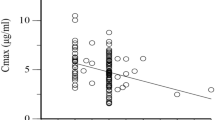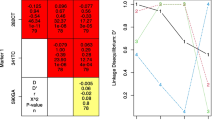Abstract
Purpose
To determine the frequency of N-acetyltransferase 2 (NAT2) polymorphisms, the NAT2 acetylation profile and its relation to the incidence of gastrointestinal adverse drug reactions (ADRs), anti-tuberculosis (TB) drug-induced hepatotoxicity, and the clinical risk factors for hepatotoxicity in a population from Brazil.
Methods
Two hundred and fifty-four Brazilian TB patients using isoniazid (INH), rifampicin (RMP), and pirazinamide (PZA) were tested in a prospective cohort study. NAT2 genotyping was performed by direct PCR sequencing. The association between gastrointestinal ADRs/hepatotoxicity and the NAT2 profile genotype was evaluated by univariate analysis and multiple logistic regression.
Results
Of the 254 patients analyzed, 69 (27.2%) were slow acetylators and 185 (72.8%) were fast acetylators. Sixty-five (25.6%) patients were human immunodeficiency virus (HIV)-positive. Thirty-three (13%) and 14 (5.5%) patients developed gastrointestinal ADR and hepatotoxicity, respectively. Of the 14 hepatotoxicity patients, nine (64.3%) were slow acetylators and five (35.7%) were fast acetylators. Sex, age, presence of hepatitis C virus, alcohol abuse, and baseline aminotransferases were not found to be risk factors for hepatotoxicity. However, logistic regression analysis revealed that slow acetylator status and the presence of HIV (p < 0.05) were independent risk factors for hepatotoxicity.
Conclusions
Our findings show that HIV-positive patients that have the slow acetylation profile are significantly associated with a higher risk of developing hepatotoxicity due to anti-TB drugs.

Similar content being viewed by others
References
Brasil (2002) Guia de Vigilância Epidemiológica, 1st edn. Fundação Nacional de Saúde/Funasa, Brasília
Ingelman-Sundberg M (2001) Pharmacogenetics: an opportunity for a safer and more efficient pharmacotherapy. J Intern Med 250:186–200
Lundkvist J, Jonsson B (2004) Pharmacoeconomics of adverse drug reactions. Fundam Clin Pharmacol 18:275–280
Pande JN, Singh SP, Khilnani GC, Khilnani S, Tandon RK (1996) Risk factors for hepatotoxicity from antituberculosis drugs: a case-control study. Thorax 51:132–136
Ungo JR, Jones D, Ashkin D, Hollender ES, Bernstein D, Albanese AP, Pitchenik AE (1998) Antituberculosis drug-induced hepatotoxicity. The role of hepatitis C virus and the human immunodeficiency virus. Am J Respir Crit Care Med 157:1871–1876
Yee D, Valiquette C, Pelletier M, Parisien I, Rocher I, Menzies D (2003) Incidence of serious side effects from first-line antituberculosis drugs among patients treated for active tuberculosis. Am J Respir Crit Care Med 167:1472–1477
Ohno M, Yamaguchi I, Yamamoto I, Fukuda T, Yokota S, Maekura R, Ito M, Yamamoto Y, Ogura T, Maeda K et al. (2000) Slow N-acetyltransferase 2 genotype affects the incidence of isoniazid and rifampicin-induced hepatotoxicity. Int J Tuberc Lung Dis 4:256–261
Huang YS, Chern HD, Su WJ, Wu JC, Lai SL, Yang SY, Chang FY, Lee SD (2002) Polymorphism of the N-acetyltransferase 2 gene as a susceptibility risk factor for antituberculosis drug-induced hepatitis. Hepatology 35:883–889
Vuilleumier N, Rossier MF, Chiappe A, Degoumois F, Dayer P, Mermillod B, Nicod L, Desmeules J, Hochstrasser D (2006) CYP2E1 genotype and isoniazid-induced hepatotoxicity in patients treated for latent tuberculosis. Eur J Clin Pharmacol 62:423–429
Higuchi N, Tahara N, Yanagihara K, Fukushima K, Suyama N, Inoue Y, Miyazaki Y et al. (2007) NAT2*6A, a haplotype of the N-acetyltransferase 2 gene, is an important biomarker for risk of anti-tuberculosis drug-induced hepatotoxicity in Japanese patients with tuberculosis. World J Gastroenterol 13:6003–6008
Hughes HB, Biehl JP, Jones AP, Schimdt LH (1954) Metabolism of isoniazid in man as related to the occurrence of peripheral neuritis. Am Rev Tuberc 70:266–273
Evans DAP, White TA (1964) Human acetylation polymorphism. J Lab Clin Med 63:394–401
Weber WW, Hein DW (1979) Clinical Pharmacokinetics of isoniazid. Clin Pharmacokinet 4:401–422
Mitchell JR, Thorgeisson UP, Black M et al. (1975) Increased incidence of isoniazid hepatitis in rapid acetylators: possible relation to hydralazine metabolites. Clin Pharmacol Ther 18:70–79
Lin HJ, Han CH, Lin BK, Hardy S (1993) Slow acetylator mutations in the human polymorphic N-acetyltransferase gene in 786 Asians, Blacks, Hispanics and Whites: application to metabolic epidemiology. Am J Hum Genet 52:827–834
Doll MA, Fretland AJ, Deitz AC, Hein DW (1995) Determination of human NAT2 acetylator genotype by restriction fragment length polymorphism and allele specific amplification. Anal Biochem 231:412–420
Cho HJ, Koh WJ, Ryu YJ, Ki CS, Nam MH, Kim JW, Lee SY (2007) Genetic polymorphisms of NAT2 and CYP2E1 associated with antituberculosis drug-induced hepatotoxicity in Korean patients with pulmonary tuberculosis. Tuberculosis 87:551–556
Sarma GR, Immanuel C, Kailasan S, Narayana ASL, Venkatesan P (1986) Rifanpin-induced release of hydrazine from isoniazid. A possible cause of hepatitis during treatment of tuberculosis with regimens containing isoniazid and rifanpin. Am Rev Respir Dis 133:1072–1075
Singh J, Garg PK, Thakur VS, Tandon RK (1995) Antitubercular treatment induced hepatotoxicity: does acetylator status matter? Indian J Physiol Pharmacol 39:43–46
Parthasarathy R, Sarma GR, Janardhanam B, Ramachandran P, Santha T, Sivasubramanian S, Somasundaram PR, Tripathy SP (1986) Hepatic toxicity in South Indian patients during treatment of tuberculosis with short-course regimens containing isoniazid, rifampicin and pyrazinamide. Tubercle 67:99–108
Secretaria Estadual da Saúde (2001) Norma Técnica da política de Controle da Tuberculose. Rio Grande do Sul, Porto Alegre
Mayfield D, McLeod G, Hall P (1974) The CAGE questionnaire: validation of a new alcoholism screening instrument. Am J Psychiatry 131:1121
Castelo Filho A, Kritski AL, Barreto AW, Lemos ACM, Neto AR, Guimarães CA, Silva CL (2004) II Consenso Brasileiro de Tuberculose: Diretrizes Brasileiras para Tuberculose. J Bras Pneumol 30 Suppl 1
Bénichou C (1990) Criteria of drug-induced liver disorders:report of an international concensus meeting. J Hepatol 11:272–276
Muller AS, Dykes DD, Polesky HF (1988) A simple salting out procedure for extracting DNA from human nucleated cells. Nucleic Acids Res 16:1215
Teixeira RL, Miranda AB, Pacheco AG, Lopes MQ, Fonseca-Costa J, Rabahi MF, Melo HM et al. (2007) Genetic profile of the arylamine N-acetyltransferase 2 coding gene among individuals from two different regions of Brazil. Mutat Res 624:31–40
Long JC, Willians RC, Urbanek M (1995) An E-M algorithm and testing strategy for multiple-locus haplotypes. Am J Hum Genet 56:799–810
Long JC (1999) Multiple locus haplotype analysis, version 2.0. Software and documentation distributed by the autor. Section on population genetics and linkage. Laboratory of Neurogenetics (NIAAA), National Institute of Health, Bethesda
Feterson RJ, Goldman G, Long JC (1999) Effects of worldwide population subdivision on ALDH2 linkage disequilibrium. Genome Res 9:844–852
Gurumurthy P, Krishnamurthy MS, Nasareth O, Parthasarthy R, Samara GR, Somasundaran PR (1984) Lack of relationship between hepatotoxicity and acetylator phenotype in three thousand south Indian patients during treatment with isoniazid for tuberculosis. Am Rev Respir Dis 129:58–61
Fernandez-Villar A, Sopena B, Fernandez-Villar J, Vazquez-Gallardo R, Ulloa F, Leiro V, Mosteiro M, Pineiro L (2004) The influence of risk factors on the severity of anti-tuberculosis drug-induced hepatotoxicity. Int J Tuberc Lung Dis 8:1499–1505
Huang YS (2007) Genetic polymorphisms of drug-metabolizing enzymes and the susceptibility to antituberculosis drug-induced liver injury. Expert Opin Drug Metab Toxicol 3:1–8
Thomas BH, Wong LT, Zeitz W, Solomonarj G (1981) Isoniazid metabolism in the rabbit, and the effect of rifampin pretreatment. Res Commun Chem Pathol Pharmacol 33:235–247
Agundez JAG, Martinez C, Oliveira M, Ledesma MC, Ladero JM, Benitez J (1994) Molecular analysis of the arylamine N-acetyltransferase polymorphism in a Spanish population. Clin Pharmacol Ther 56:202–209
Baillet G, Santos MR, Alfaro EL, Dipierri JE, Demarchi DA, Carnese FR, Bianchi NO (2007) Allele and genotype frequencies of metabolic genes in Native Americans from Argentina and Paraguay. Mutat Res 627:171–177
Parra FC, Amado RC, Lambertucci JR, Rocha J, Antunes CM, Pena SDJ (2003) Color and genomic ancestry in Brazilians. Proc Natl Acad Sci USA 63:623–628
Salzano FM, Freire-Maia N (1970) Problems in human biology. A study of Brazilian populations. Wayne State University Press, Detroit
Hiratsuka M (2002) Development of simplified and rapid detection assay for genetic polymorphisms influencing drug response and its clinical applications. Yakugaku Zasshi 122:451–463
Acknowledgments
The authors wish to thank trial participants for their consent and participation in the study, and we also thank the staff of the outpatient Department and Research and Knowledge Department from Sanatorio Partenon Hospital for their assistance. This work was supported by National Council for Research (CNPq), Laboratório Exame, Novo Hamburgo, RS, and PADCT/ FEPPS. Adalberto R. Santos is supported by CNPq Grant number 308786/2005-0. We declare that the experiments comply with the Brazilian current laws.
Author information
Authors and Affiliations
Corresponding author
Electronic supplementary material
Below is the link to the electronic supplementary material.
Supplementary Table 1
Analysis of medication type and drug groups in use by patients studied (DOC 62 KB)
Rights and permissions
About this article
Cite this article
Possuelo, L.G., Castelan, J.A., de Brito, T.C. et al. Association of slow N-acetyltransferase 2 profile and anti-TB drug-induced hepatotoxicity in patients from Southern Brazil. Eur J Clin Pharmacol 64, 673–681 (2008). https://doi.org/10.1007/s00228-008-0484-8
Received:
Accepted:
Published:
Issue Date:
DOI: https://doi.org/10.1007/s00228-008-0484-8




